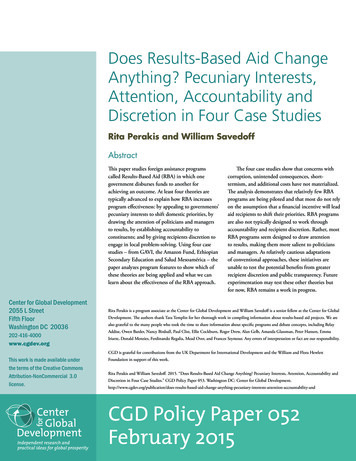
Transcription
Does Results-Based Aid ChangeAnything? Pecuniary Interests,Attention, Accountability andDiscretion in Four Case StudiesRita Perakis and William SavedoffAbstractThis paper studies foreign assistance programscalled Results-Based Aid (RBA) in which onegovernment disburses funds to another forachieving an outcome. At least four theories aretypically advanced to explain how RBA increasesprogram effectiveness: by appealing to governments’pecuniary interests to shift domestic priorities, bydrawing the attention of politicians and managersto results, by establishing accountability toconstituents; and by giving recipients discretion toengage in local problem-solving. Using four casestudies – from GAVI, the Amazon Fund, EthiopianSecondary Education and Salud Mesoamérica – thepaper analyzes program features to show which ofthese theories are being applied and what we canlearn about the effectiveness of the RBA approach.Center for Global Development2055 L StreetFifth FloorWashington DC 20036202-416-4000www.cgdev.orgThe four case studies show that concerns withcorruption, unintended consequences, shorttermism, and additional costs have not materialized.The analysis demonstrates that relatively few RBAprograms are being piloted and that most do not relyon the assumption that a financial incentive will leadaid recipients to shift their priorities. RBA programsare also not typically designed to work throughaccountability and recipient discretion. Rather, mostRBA programs seem designed to draw attentionto results, making them more salient to politiciansand managers. As relatively cautious adaptationsof conventional approaches, these initiatives areunable to test the potential benefits from greaterrecipient discretion and public transparency. Futureexperimentation may test these other theories butfor now, RBA remains a work in progress.Rita Perakis is a program associate at the Center for Global Development and William Savedoff is a senior fellow at the Center for GlobalDevelopment. The authors thank Tara Templin for her thorough work in compiling information about results-based aid projects. We arealso grateful to the many people who took the time to share information about specific programs and debate concepts, including BelayAddise, Owen Barder, Nancy Birdsall, Paul Clist, Ellie Cockburn, Roger Drew, Alan Gelb, Amanda Glassman, Peter Hansen, EmmaIriarte, Donald Menzies, Ferdinando Regalia, Mead Over, and Frances Seymour. Any errors of interpretation or fact are our responsibility.CGD is grateful for contributions from the UK Department for International Development and the William and Flora HewlettThis work is made available underthe terms of the Creative CommonsAttribution-NonCommercial 3.0license.Foundation in support of this work.Rita Perakis and William Savedoff. 2015. “Does Results-Based Aid Change Anything? Pecuniary Interests, Attention, Accountability andDiscretion in Four Case Studies.” CGD Policy Paper 053. Washington DC: Center for Global sts-attention-accountability-andCGD Policy Paper 052February 2015
ContentsIntroduction . 1What is Results-Based Aid? . 2Key Features of RBA Agreements . 5RBA Theories: Pecuniary interest, Attention, Accountability and Discretion . 8Four RBA experiences. 15Case Study 1: GAVI Immunization Services Support . 17GAVI Immunization Services Support: Key Features of RBA Agreement . 19Case Study 2: Amazon Fund . 21The Amazon Fund: Key Features of RBA Agreement . 24Case Study 3: Secondary Education in Ethiopia . 26Secondary Education in Ethiopia: Key Features of RBA Agreement . 31Case Study 4: Salud Mesoamérica 2015 . 35Salud Mesoamérica 2015: Key Features of RBA Agreement . 37Cautious implementation and few concerns but what really changed? . 39Concerns that did not materialize . 40Cautious Implementation . 42Which theory is being tested? . 44Final Reflections on RBA Experiences . 45References. 48Appendix A . 52Appendix B. 56Projects considered for inclusion in survey of RBA Programs: . 56Projects excluded because payments are not to governments . 57Projects that pay governments but were excluded because payments are not foroutcomes (or for proxies of outcomes) . 58Data collected on results-based programs (criteria for exclusion/inclusion indicated byitalics) . 59
IntroductionFor decades, aid agencies have promoted the idea of disbursing payments in relation toresults. Generally, such ideas were realized in programs that disbursed on the delivery ofphysical outputs or the enactment of laws and regulations. In the last decade, aid agencieshave sought to bring this idea into practice by paying for less tangible outputs or outcomesin the spheres of environmental, social or governance objectives.This paper surveys progress and draws lessons from a recent wave of foreign assistanceprograms – which we will call Results-Based Aid (RBA) – in which one governmentdisburses funds to another for achieving an outcome or a proxy for such an outcome. RBAis usually promoted for a mix of reasons which encompass at least four distinct theories forhow linking disbursements to results will make programs more effective: by appealing togovernments’ pecuniary interests to shift domestic priorities; by drawing the attention ofpoliticians and managers to results; by establishing accountability to constituents; and by givingrecipients discretion to engage in local problem-solving. To understand the implicit theoryembodied in programs and consequently their prospects for success, this paper focuses onsix program features: the results level (i.e., activities, outputs, or outcomes), the paymentfunction, recipient discretion, credibility in how results are verified, transparency, andpayment amounts.After discussing these theories and program features, we analyze four RBA agreements toshow which theories are actually being tested and how they function in practice. The analysisshows that concerns typically raised by critics over performance programs – such ascorruption, unintended consequences, short-termism and high transaction costs – have notmaterialized. Of greater importance, the analysis demonstrates that relatively few RBAagreements paying for outcomes (or proxies of outcomes) are actually being piloted.Furthermore, most of these programs do not rely on financial incentives in the sense ofusing money to motivate recipients to shift their domestic priorities. Most RBA programsare also not testing whether the approach increases the accountability of the developingcountry government to its constituents or gives recipients discretion to engage in localproblem-solving. Rather, drawing political and managerial attention to outcomes appears tobe the most prominent theory being tested in RBA programs as they are currently designedand implemented. Most initiatives are cautious adaptations of conventional approaches andso the potential benefits from greater recipient discretion and public transparency remain1
untested. Future experimentation may test these other theories but for now, RBA remains awork in progress.What Is Results-Based Aid?There is no widely accepted nomenclature for programs that pay for results, though therehave been numerous attempts to classify and distinguish them.1 In part, this reflects differentcommunities working on different issues. People in the private corporate world havedeveloped their own terms of practice for performance contracts, results based management,and the like.2 Similarly, the world of public administration experts has its own usage.3 Thispaper reflects terminology applied in the world of international development organizations,including bilateral aid agencies, multilateral development banks, international NGOs, and theresearchers who engage with these organizations.4Aid agencies have implemented a wide range of programs which pay for results of one kindor another. Some of these programs pay providers for delivering services, while others offerprizes for technological innovations, or reward poor families directly through conditionalcash transfers.5 All of these programs use some form of incentive to improve results, butthey vary greatly in the ways that incentives are used, the people or groups that are givenincentives, and the level of the results chain at which they operate.The focus of this paper is on a type of performance program called “Results-Based Aid”(RBA). The term RBA is used by the UK Department for International Development(DFID) to distinguish approaches which involve a contractual arrangement between a donorand national government from other performance-based approaches (Pearson 2011). Thishas become the most commonly used definition for results-based aid: a partnership betweena donor and partner government that ties disbursement to results.6 This paper uses thatdefinition, but focuses on a subset of RBA programs in which the measured results aredefined as closely as possible to development outcomes. In discussing RBA theories and case1See for example: Pearson 2011; Musgrove 2010; Savedoff 2011. For a review of results based aid andresults based financing, see Pearson, Johnson and Ellison 2010 and Janus 2014.2 One of the earliest of these is Drucker 1954.3 For an overview of different theoretical frames informing New Public Administration, see Gruening 2001.4 For a discussion of results-based management in relation to development agencies, see Meier 2003 andVähämäki et al. 2011.5 See Savedoff 2011 for more on how a range of incentive-based development programs are defined andclassified.6 See for example de Hennin and Rozema 2011; Pearson 2011; Klingebiel 2012; or DFID’s Strategy forPayment by results 2014.2
study examples, we are therefore referring to agreements in which a donor government makes ex postpayments to a national or local government for something that measures or is a proxy for an outcome.The two key features of this definition – who gets paid in the agreement and what they getpaid for – distinguish this subset of RBA from a wide range of other programs that linkpayments to performance. First, RBA agreements disburse funds to governments. This distinguishesRBA from agreements that pay individuals, households, public facilities, communities, nonprofit entities, or private businesses for some deliverable. Agreements involving this lattergroup of agents have sometimes been called “Results Based Financing” (RBF), a term whichhas been adopted by the World Bank for these kinds of health programs(www.rbfhealth.org) and Britain’s program for “Results Based Financing for Low CarbonEnergy Access.”7 RBA, which funds governments, is likely to require different designs thanRBF because the nature of governments differs from other categories of recipients in termsof resources, behaviors, and dynamics.Second, we are exploring those RBA agreements which disburse funds against outcomes (or outputindicators that closely approximate outcomes). This distinguishes outcomes-based programsfrom those that pay governments to purchase inputs, undertake activities, completeprocesses, or adopt policies which are primarily means to ends. The dividing line along thetypical “results-chain” from inputs, activities, and processes to outputs, outcomes andimpact is not exact but there is clearly a difference between programs that triggerdisbursements upon passage of a new credit law, completion of teacher training courses,construction of a power plant, or malnutrition screening for children and those whichdisburse upon verifying that poorer people are getting access to credit, 12-year-olds can readand write, electricity outages are reduced, or child mortality has declined. We focus on thesubset of RBA agreements that encompass the latter and not the former because we areinterested in examining implementation experiences with those relatively new developmentprograms which are paying for results “further along” on the chain.RBA programs can be pictured on a two-dimensional figure that distinguishes differentagents on the vertical axis and results levels on the horizontal axis (See Figure 1 and Figure2). RBA programs are in the top of the diagram because they pay national governments. Thesubset of RBA agreements that interest us are located in the northeast quadrant because theyaim to reward outcomes. This subset is different from programs that pay individuals 2957/3
outcomes (e.g., successful completion of tuberculosis treatments); that pay individuals forinputs (e.g., provide vouchers to individuals for cook stove purchases); and that pay nationalgovernments for inputs (e.g., policy loan disbursements for enacting laws).Figure 1: Performance programs by recipient type and results levelInput / Processes / ActivitiesOutputsOutcomesNationalGovernmentState & LocalGovernmentsLarge CSOs,NGOs, & FirmsOutcomes‐Based RBAResultsBased AidConventional AidResults BasedFinancingCommunities,Facilities &FirmsHouseholdsIndividualsSource: Authors.Figure 2: Performance programs classified by recipient type and results levelInput / Processes / ActivitiesNationalGovernmentState & LocalGovernmentsLarge CSOs,NGOs, & FirmsPolicy LoansOutcomesEU Variable TrancheWorld Bank Program for ResultsResultsBased AidConventionalConstructionProjectsResults BasedFinancingCommunities,Facilities ments toReduceDeforestationOutput‐BasedAidConditional CashTransfersVoucher DistributionCOD AidTB treatmentcompletionSource: Authors.Notes: CSOs Civil Society Organizations; NGOs Non-Governmental Organizations.4
Key Features of RBA AgreementsTo fully characterize an RBA program, though, it is necessary to specify much more than thenature of the recipient (e.g., a government) and the results level (e.g., a measure of or proxyfor an outcome). From our review, we developed a list of eleven design features thatdistinguish one RBA agreement from another (see Appendix A) and represent choicespolicymakers face when establishing performance agreements. In this paper, we chose tofocus on six features that we judged particularly essential to predicting how an RBA programwill function. They are: Results level: This paper focuses on agreements that pay in proportion to outcomes orproxies for outcomes. In practice, many agreements pay for changes at differentpoints on the “results chain” – whether that means paying upon purchase of specificinputs, the completion of certain tasks or activities, enacting regulations or laws,establishing procedures, or producing goods or services.8 Programs are likely to getmore of what they pay for, whether those are inputs, processes, or outcomes. Payment function: Payments can be made in proportion to progress, in which case theyare a continuous function. Alternatively, payments may be made in tranches formeeting a target or for passing a predetermined threshold. Sometimes payments aretriggered by whatever results are achieved at a certain date, while in other cases thedate of the payment depends upon when targets are achieved. Continuous functions(in progress units or time) create incentives for marginal improvements at any levelof progress whereas thresholds and step functions create discontinuities that mayundermine incentive effects at different achievement levels.9 Recipient discretion: Agreements can give recipients varying degrees of authority todecide for themselves how they will achieve results and how they will spendpayments. Greater recipient discretion may increase the recipient’s level ofcommitment and improve chances of success by giving recipients’ flexibility inimplementation, opportunities to innovate, and the ability to be more responsive toconstituents.8 Perakis and Savedoff, 2014 offers examples of input, output, and outcome indicators for severaldevelopment sectors.9 For a discussion of the implication of payment functions within performance payment programs, seeHallett and Over 2010 with an illustration for programs to reduce the prevalence of HIV/AIDS.5
Credibility: An agreement’s credibility will influence whether the parties pay attentionto it and whether it is likely to motivate change. The funder’s credibility in terms offulfilling commitments to pay and not to pay is important if the recipient is going torespond to the opportunity provided by the agreement. The credibility of theperformance measurement is particularly important for RBA programs becauseindicators of performance determine disbursements. To avoid manipulation ofperformance measures, RBA agreements can contract an independent agent toverify results. They can also arrange for the collection of independent informationto either generate results estimates or cross-check a governmental reporting system.Credible performance measurement can increase the chance that funders will abideby the agreement and that recipients will focus on achieving real progress. Transparency: The transparency of an agreement creates opportunities for moreactors to influence a program. Agreements that are structured in ways that facilitatepublic dissemination are easier for officials themselves to understand and manage.The degree of transparency also introduces additional sources of feedback andaccountability – from beneficiaries, civil society, employees, and peer governmentsamong others – which may encourage better performance. Payment Amount: The payment amount may be significant in relation to unit costs orrelative to other funding sources. Some agreements fully reimburse unit costs andeven provide bonuses, while others only subsidize costs or provide rewards andprizes that are a small share of costs. Some agreements represent potential payoutsthat are large relative to domestic budgets or other foreign aid opportunities whileothers are marginal. When payment amounts are small, relative to unit costs or toother funding sources, they still signal changes in outcomes that may be useful formanagement or accountability but their impact via pecuniary interests will beattenuated.The six features emphasized here are also reflected in the results-based approach proposedby Birdsall and Savedoff (2010) called “Cash on Delivery Aid” (COD Aid). Birdsall andSavedoff argued that five key features are critical for effective agreements because thesefeatures can simplify the funder-recipient relationship, shift funders’ attention to measuringand paying for development outcomes, and open space for recipients to focus on achievingprogress (see Box 1).6
Box 1: Five Key Features of COD Aid Payment for outcomes, not inputs: The program starts by defining an outcomerelated to an objective shared by both funder and recipient. Outcomes should bemeasurable and continuous so that progress can be rewarded over time in proportion toincremental improvements. Hands off funders, responsible recipients: Recipients assume full responsibility forthe program. Funders do not specify or monitor inputs, set policy conditions, or trackthe use of COD Aid funds. Rather, they verify progress toward the shared objective,provide technical assistance only upon demand, and pay for outcomes according to theCOD Aid agreement. Independent verification of progress: Results are independently verified by a thirdparty to ensure that both the funder and the recipient have confidence in the way thatprogress is measured. Transparency and public dissemination: Both the contract and progress measuresshould be as simple as possible and made publicly available. This increases credibilityand accountability, and makes it possible for constituents in each country to monitorand hold their own governments accountable for progress. Complementarity with other aid programs: COD Aid is intended to complementand not disrupt ongoing programs, whether funded by local or external sources. CODAid should help the country use all available resources more effectively.Source: Birdsall and Savedoff 2010.To sum up, this paper discusses a subset of RBA performance agreements that make ex post paymentsto a national or local government based on indicators that measure or are a proxy for outcomes. Within thissubset, substantial design variation remains in terms of results levels, payment functions,recipient discretion, credibility, transparency, and payment amounts. Differences in thesefeatures could have large implications for the effectiveness of an agreement depending on itsunderlying theory, an issue to which we now turn.7
RBA Theories: Pecuniary Interest, Attention,Accountability and DiscretionProponents of RBA assert that linking payments to outputs and outcomes will lead tochange more effectively than conventional aid approaches for different reasons. Someproponents argue that when payments are linked to results, recipient governments respondbecause of their pecuniary interest – they will shift their domestic priorities or exert greatereffort because they need the funding. Other proponents highlight how performancepayments make results visible in a way that draws the attention of politicians and bureaucratsto outcomes or generate accountability to constituents. A fourth group of proponentsemphasize how RBA allows funders to give recipients greater discretion duringimplementation, creating opportunities to adapt and learn. The particular features designedinto an RBA program will reveal which of these theories is really being piloted, which may ormay not align with explicit justifications in program documents.Theories that focus on pecuniary interest argue that “you get what you pay for.” Peoplewho emphasize such theories criticize conventional aid for rewarding governments whenthey complete tasks and paperwork independent of progress in improving outcomes. Payingfor outcomes instead, it is argued, motivates a recipient government to deliver goods andservices that will have a measurable influence on the outcome measure because thegovernment needs or is mainly attracted by the money. Faced with this pressure,governments are expected to shift resources – whether physical, financial, managerial, orpolitical – toward the desired outcome and to choose the most effective and least costlyapproaches for attaining that end.The most common foundation for this approach is from institutional economics and,particularly, from principal-agent models.10 When these models are used, funders are treatedas “principals” who are trying to achieve an objective by contracting with a recipient who isconceived as an “agent.” Fundamental to these theories is a divergence in objectives betweenprincipals and agents which principals “solve” by offering a contract that aligns agents’incentives with their own. Seen this way, an RBA program makes a recipient explicitly face atradeoff between shifting resources toward the funder’s objectives (in return for funding)and continuing to pursue their own objectives (and give up the funds).10 See Sappington 1991 for a general treatment of incentives. Clist and Verschoor 2014 use the principalagency literature to elucidate RBA and RBF programs.8
Principal-agent models may not be relevant to RBA agreements because they have beendeveloped and tested primarily for interactions among individuals and firms, notgovernments or multilateral organizations. Furthermore, most aid relationships areconceived as partnerships between sovereign governments in which objectives aresubstantially overlapping even if there are areas of divergence. Of even greater importance,governments are not unitary actors with well-defined preferences or direct links betweendecisions and action.For these reasons, political-economy approaches are likely to be more relevant forrelationships between governments than principal-agent models, though few such theorieshave been advanced in the international aid literature to explain why financial incentiveswould motivate changes in public policy (Levy 1997). The only empirical literature of whichwe are aware that looks specifically at how national governments respond to externalfinancial incentives relates to the debate over policy reform loans in the 1980s and 1990s(Killick 1998; Dollar and Svensson 2000). This literature generally finds little evidence thatthe conditionality in these incentive programs was able to induce domestic policy reforms.This could have been because the incentives were not attractive enough; because theinternational agencies lacked credibility since they commonly waived policy conditions; orbecause governments, as complex political organizations, do not respond in a direct andsimple fashion to financial inducements.If pecuniary interest is the key mechanism to induce change, then outcomes, paymentamounts, and credibility will all be critical features for an RBA agreement. If you are likely to“get what you pay for” then you want to make sure you “pay for what you (really) want.”This will generally mean paying for impact, if possible, but certainly for outcomes rather thaninputs, activities or processes. The payment amount will make a big difference because when itis larger, it will have more power to motivate and mobilize action. Finally, credibility ofmeasurement will be important because recipients need confidence that the measurement ofresults is accurate and that payments will only be forthcoming in relation to thosemeasurements. Otherwise, they may discount the value of the financial incentive and exertless effort.Other arguments downplay the importance of pecuniary interests and emphasize, instead,that RBA agreements increase aid effectiveness by bringing the attention of politicians,bureaucrats and managers to outcomes in a way that focuses them on achieving progress.This is not too far from the adage that “you can’t manage what you don’t measure.” Works9
in the field of business management, psychology and economics (e.g., bounded rationality)recognize that people have limited capacities to absorb information and make decisions. As aresult, they will generally act on the limited information available to them rather than expendefforts to find the information they need (Greenberg 2004; Kahneman 2003). Politicians,bureaucrats and managers are more likely to be faced with information about inputs – likebudgets, disbursements and hiring decisions – than with information about what publicprograms are achieving. Similarly, conventional aid programs tend to spend more timemonitoring inputs, activities and processes than they do documenting changes in outcomesand trying to relate them to different interventions. By paying for results, RBA agreementsgenerate information that reaches policymakers because the funding linked to these results isa tangible signal – even when the payment amounts are small.If drawing attention to outcomes is the key mechanism for change, then paying foroutcomes is the critical feature for an RBA agreement. As with pecuniary interest, choosingresults which come close to measuring real goals of public policy will be important becauseotherwise people will have their attention diverted to less important or less effectiveactivities. The payment amount is less important here because even a low cost share – in theform of a prize, reward or subsidy – is sufficient to make performance visible and providefeedback to politicians and managers. Higher amounts would generate more attention buteven small amounts provide a signal that funding is linked to progress on outcomes and nolonger linked to inputs and activities.A third theory argues that RBA programs induce change by generating governmentaccountability toward constituents. Traditional aid arrangements typically hold recipientgovernments accountable to funding agencies. This can disrupt the important relationshipbetween a recipient government and its domestic constituencies. RBA programs canexacerbate this problem if they are designed primarily to make recipients shift thei
Discretion in Four Case Studies Rita Perakis and William Savedoff Center for Global Development 2055 L Street Fifth Floor Washington DC 20036 202-416-4000 . After discussing these theories and program features, we analyze four RBA agreements to show which theories are actually being tested and how they function in practice. The analysis










